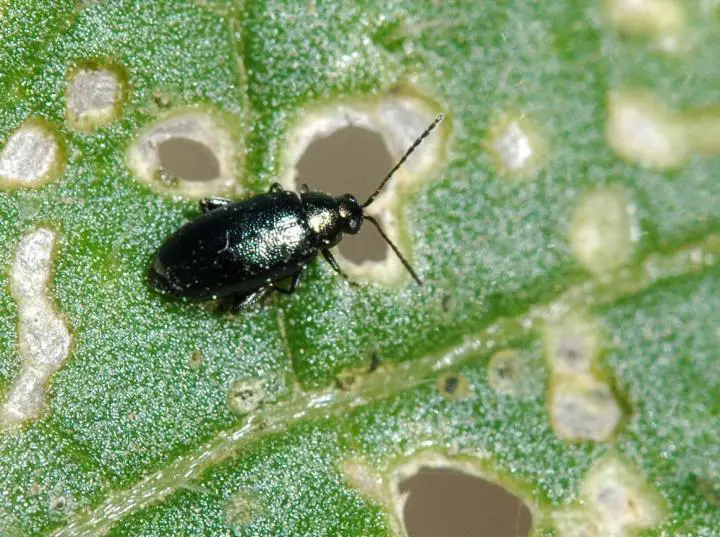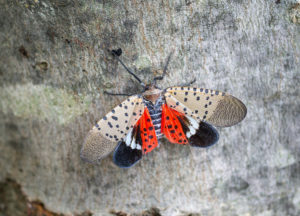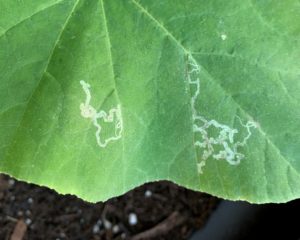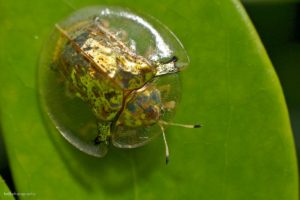If your plants have small, round, or sometimes irregularly shaped holes in their leaves, it could be a sign that flea beetles are making their home in your garden. The term flea beetle refers not to an individual species but to a group of beetles characterized by their petite size and powerful hind legs that enable them to jump like fleas when disturbed. They are found throughout North America and range in size from 1/16 to 1/8 of an inch. They are often black and metallic but can also be brown, tan, green, striped, or spotted. Different flea beetles target different types of vegetation. For example, one type of flea beetle prefers nightshades like tomatoes, potatoes, peppers, and eggplant, while another prefers brassicas like broccoli, Brussels sprouts, and radishes. Spinach is also a prime target for these tiny beetles.
Life Cycle
Adult flea beetles overwinter in garden debris or wooded areas. When spring arrives and the temperatures reach a consistent 50° F (10° C), they emerge and begin to feed on their preferred vegetation. Once adult beetles mate, the females will lay small white eggs at the base of plants. About one week later, white or cream colored larvae will hatch and begin to feed on roots and germinating seeds. Some larvae may also feed on leaves or plant stems. After a period of two to three weeks, the larvae will pupate in the soil and emerge as adults one week later. Depending on the species, this cycle may be repeated as many as four times per year.
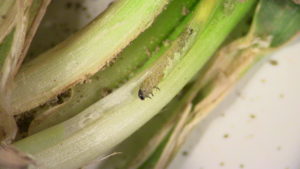
Damage
The damage caused by flea beetles is often described as buckshot because of the scattered pattern of holes they leave in the foliage. Others describe it as looking like a sieve.
If you suspect flea beetles are eating your plants, it is important to take action right away as this little garden pest can do quite a bit of damage in a short period of time, particularly if there is an infestation. Not only is the damage unsightly, especially for crops like spinach and lettuce, but it can also stunt the plant’s growth. What’s more, flea beetles can carry viral and bacterial diseases such as blight. Young plants are particularly susceptible to flea beetle damage.
Prevention Methods
Clean Up -To help prevent flea beetles, remove weeds, garden debris, leaf piles, woodpiles, etc., from the vicinity of your garden. These are prime locations for garden pests to overwinter.
Delayed Planting – If you have had flea beetles in the past, consider delaying the planting of crops by several days in the spring. This will deprive emerging beetles of their preferred food and they will go elsewhere to feed.
Mulch – Add a layer of mulch to your beds or containers. Not only is this a good moisture retention method, but it will also hinder any adults from coming up from the soil after pupating to feed.
Take Care of Your Plants – Stressed plants attract flea beetles and other pests. So be sure to water and fertilize your plants when needed. Plus, a healthy plant has a better chance of surviving an attack.
Companion Planting – Catnip, basil, marigold, onions, mint, and thyme make good companion plants because their aroma is said to repel flea beetles.
Trap Crops – Plant trap crops like radishes and nasturtiums to attract flea beetles where they can be treated. Afterward, plant the crops you plan to harvest. Alternatively, plant a trap crop at the same time you plant the rest of your garden.
This article contains affiliate links. If you make a purchase using one of these links, I will receive a very small commission at no additional cost to you, and it will help me maintain this website. Rest assured, I only recommend products I actually like!
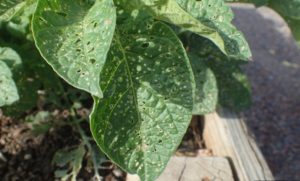
Row Covers – Row covers like the one I use are a great option to protect your garden from pests, especially when used on seedlings and new transplants. You will need to make sure that the edges of the cover are flush to the ground or sealed to the best of your ability to keep the insects out. If the plants you are covering will require pollination, you will need to remove the cover once the plants put out flowers.
Rotate Crops – Another helpful way to prevent flea beetles is to rotate crops. For example, if you had flea beetles in one area, do not grow a plant from the same family in that area since flea beetles are plant specific. If you grew a brassica, try a cucurbit in that area instead, and so forth. This will deprive the flea beetle of its preferred food.
Organic Treatment Options for Flea Beetles
There are a number of ways to combat flea beetles organically. You will have better success if you implement them early before an infestation develops. The longer you wait, the more difficult the problem will be to eradicate.
Removal – Flea beetles are quick, making them difficult, although not impossible, to catch by hand. Some suggest using your vacuum cleaner to suck up the little creatures.
Diatomaceous Earth – Food-grade diatomaceous earth (DE), a finely powdered substance made from fossilized marine life, is a staple for organic gardens. When an insect moves across the powder, the sharp micro-fragments scrape the exoskeleton causing it to die. (For this reason, you may want to protect your eyes and avoid inhaling the powder as it could possibly harm your lungs.) DE is non-toxic, but it can harm pollinators, so be sure to dust your plants late in the day when they are no longer around and avoid dusting flowers. You will need to reapply DE if it becomes wet.
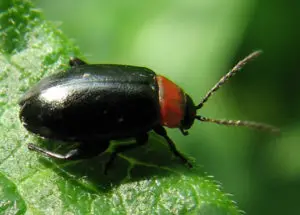
Insecticidal Soap – Insecticidal soap is another time-tested way to manage flea beetles. If it is sprayed on them directly, it can suffocate them. Or if you spray the entire plant, including the underside of leaves, it will act as an antifeedant.[1]
To make your own insecticidal soap spray, add one teaspoon of Castile soap like Dr. Bonner’s or Dr. Wood’s, to a one-quart spray bottle filled with water. Mix well. Always do a test spray on one leaf and wait 24-48 hours to see if there are any adverse reactions. Then spray the plant thoroughly. Repeat every week until the problem is resolved. Do not spray during the day as it could burn your plants.
Neem Oil – Another tried and true organic method for treating flea beetle eggs, larvae, and adults is neem oil. You can make an effective spray by adding an organic neem oil that is cold-pressed and contains the naturally occurring chemical called Azadirachtin. This is the neem oil I use. Mix one teaspoon of neem oil with 1/2 teaspoon of Castile soap, like Dr. Bronner’s or Dr. Wood’s, to 1 quart of water. Mix well. Do a test spray on one leaf and wait 24 to 48 hours to make sure the mixture is not too strong. If the leaf is damaged, decrease the amount of neem oil. If there is no damage, spray the plants, making sure to cover both sides of the leaves. If it rains, you will need to reapply. If the solution does not seem to be effective, increase the amount of neem oil to as much as 2 teaspoons. Be sure to do another test spray. Do not apply during the day as the combination of sun and neem oil can burn the plant. Instead, apply during the cool early morning hours or in the early evening.
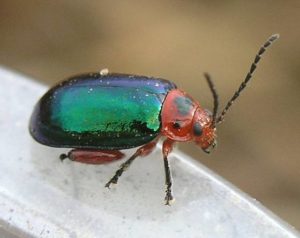
Sticky Traps – Many recommend placing yellow sticky traps near plants with flea beetles. The traps, which are very sticky, can be effective, but they can also be a bit challenging to work with. Like other insect control methods, they may trap beneficial insects as well.
Beneficial Insects – Insects like braconid wasps and tachinid flies will eat flea beetle larvae. You can attract these and other beneficial insects to your garden by planting dill, coriander, parsley, asters, and nectar-producing flowers.
Beneficial Nematodes – Microscopic worms called nematodes can be added to the soil to destroy flea beetle larvae. These naturally occurring predators will hunt down the larvae but are not harmful to people, pets, or earthworms. They should not be confused with harmful nematodes like root knot nematodes.
While flea beetles can pose a problem, they don’t have to spell disaster for your garden. By implementing the prevention methods and one or more of the treatment methods, you should be able to reap a bountiful harvest.
Thank you for reading this article! If you found it helpful, please consider sharing it with others on social media!
[1] An antifeedant is an agent that deters feeding.
